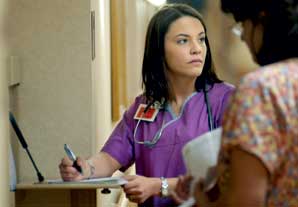As the national nursing shortage deepens, educators in the Flathead are applying local solutions to a national problem – they’re training their own nurses.
The Flathead Valley Community College Licensed Practical Nursing program graduated its second class last fall, giving the school a total of 16 graduates to date – seven in 2007 and nine last year. Myrna Ridenour, a registered nurse at Kalispell Regional Medical Center and the program’s interim director, said it’s important for the Flathead to train and retain its own nurses, especially in light of the nursing shortage.
Students at FVCC have the opportunity to do their LPN training near home and then find a job in the Flathead’s growing health care sector. Or if they choose to pursue an associate’s or bachelor’s degree to become a registered nurse (RN) at another college, they already have many of the prerequisites completed.
“Sometimes when they go away for school, they don’t come back,” Ridenour said. “The point is to train them here in the valley and keep them here in the valley.”
Licensed practical nurses are trained to perform a variety of medical procedures, but lack the advanced training of a registered nurse. They are known for their efforts in the long-term care of elderly, which is a pressing need as the baby boomer generation ages. They’re also prevalent throughout clinics and hospitals for a variety of other purposes, not the least of which is chronic pain.
“This level of nursing is really important,” Ridenour said.
 |
|
Cody Bartholomew, left, begins her night shift at Kalispell Regional Medical Center by checking each patients chart and getting caught up on their status. |
When students complete the two-year FVCC program, they are licensed practical nurses but not registered nurses. Ridenour estimates about half of FVCC’s graduates remain LPNs, while the rest move on to other colleges for advanced nursing degrees. Many go to Montana State University, a well-respected nursing school.
For students hoping to obtain their bachelor’s degree without straying far from home, MSU offers a program in the Flathead. Each year, eight students complete their registered nursing degree here by taking MSU classes via videoconferencing, which constitutes their class work. For their clinical requirements, they work at local health care providers. Registered nursing degrees are also available through Salish Kootenai College.
Gretchen McNeely, an associate dean at the MSU College of Nursing in Bozeman, said it’s everything MSU can do just to keep up with demand for nurses and interest in the program. The school has more than 800 students spread out over five campuses across the state, including the main campus in Bozeman.
Factor in the other nursing school opportunities – from Miles City Community College to MSU-Northern to Carroll College – and almost 1,000 students are getting their training in Montana. That bodes well for the state’s job market, as nursing has one of the best job placements of any profession and roughly 75 percent of nursing graduates stay in the Big Sky state.
“Our graduates don’t have any problem finding jobs,” McNeely said.
The FVCC nursing program is currently in a transition stage as it adapts its schedule to match MSU and Salish Kootenai College and searches for a new director. The school is also looking for more faculty to teach. Classes will be offered in the fall and spring now. Summers classes are no longer available. The fall semester begins on Aug. 28.
Ridenour said the Montana Board of Nursing approved the program for five more years in October. Over the next several years, Ridenour imagines the program will continue to grow, most likely keeping pace with the region’s expanding health care industry. The “huge shortage” of nurses, as Ridenour puts it, doesn’t appear to be going away anytime soon.
“(Interest) is increasing,” Ridenour said. “We get lots of inquiries all the time.”